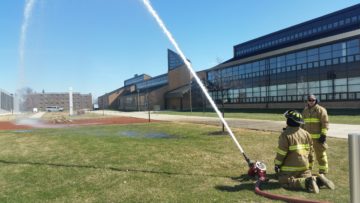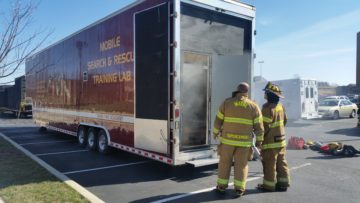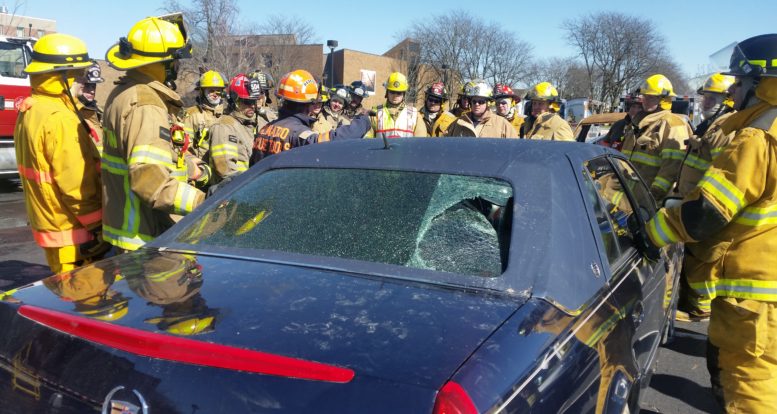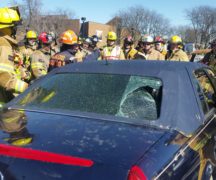By JAN LARSON McLAUGHLIN
BG Independent News
As a young boy, Tim Schroeder remembers kids chasing behind fire trucks, then watching in awe as volunteer firefighters battled blazes. Children dreamed of becoming firefighters, and as soon as reaching adulthood, many joined the ranks.
That was then.
Now, most kids don’t race behind fire trucks, they have different dreams, and most don’t sign up on volunteer fire departments. Most prefer jobs that pay, that have reasonable hours and that don’t demand quick departures during dinner or in the middle of a deep sleep.
That has some volunteer fire departments struggling to survive. Add to that the training requirements, the equipment costs, the calls at all time of day and night, and the fact that many employers no longer let volunteer firefighters leave work for fire calls.
Despite all those odds, Wood County still has 23 fire departments, the vast majority volunteer. A few neighboring departments have merged to become fire districts, but only one – Jerry City – has shut down in the last few decades.
Though their memberships are shrinking, and in some cases graying, the fire departments are a source of community pride and camaraderie.
“There’s still the excitement,” Schroeder, a member of Weston EMS, said Saturday during the Northwestern Ohio Volunteer Firemen’s Association training held at Bowling Green State University. “It’s just a struggle to get personnel.”
The volunteer job demands time and dedication.

Firefighters work on shuttling water during training.
One of the hurdles to getting and retaining firefighters is the training. Over the weekend, about 700 area volunteer firefighters were at BGSU trying to rack up some free training hours. The basic initial firefighter training is 36 hours. That used to be good enough to keep someone on the department for a lifetime. But now an additional 18 hours of training is required each year.
“You used to get a certification and that was it,” said Tom Bentley, from Wayne Volunteer Fire Department.
“The older guys don’t want to maintain that,” said Dave Miller, from Woodville Township Fire Department and chairman of the fire school.
In addition to firefighting skills, the volunteers learn how to handle hazardous materials, search and rescue skills, emergency medical skills, and how to drive fire trucks. Over the weekend, there were classes on handling agricultural accidents, tanker shuttles to put out fires where there are no fire hydrants, fire investigations, the heroin epidemic, meth labs, natural gas safety, silo explosions and severe weather.
“It’s hard to attract people with all the training requirements,” said Ryan Lee, of Central Joint Fire District. But then, there is a reason for the training. “It’s a dangerous job,” he said.
Some departments have weekly training for the firefighters, like Central Joint, which drills every Tuesday evening. While that is useful, it leaves little time for the socialization that previously attracted firefighters, and it’s more time away from family which is already an issue for some volunteers.
Back in the 1970s and 1980s, being on a volunteer fire department was like being a member of a fraternity, Lee said.
“It was more of a social group,” he said. “Now it’s a second job” – but without the pay.
Central Joint averages 260 fire and EMS runs a year. So that means multiple times a week, “you’re leaving your dinner table” or other family times to respond to emergencies, Lee said.
Like other departments in the county, Central Joint is seeing declining membership, despite its ability to attract BGSU student members due to its close proximity to the university. The department normally has 35 members, but is now down to 25. “We’re probably at the lowest we’ve been,” Lee said.
Weston has also seen a dip, from 35 active members to about 28.
That’s different than the past, according to Brad Gilbert, Wood County Emergency Management Agency director and co-chairman of the fire school.
“You always had a waiting list,” Gilbert said of the past.

Firefighters train for search and rescue in smoke-filled trailer.
Wayne’s department is beating the odds right now, with 32 members, many who are younger.
“We’re lucky,” Bentley said. “I know not everybody has that luxury.”
Some departments rely heavily on a couple families to supply members.
“The guys that are really making some departments now are family members,” Schroeder said, noting some volunteer fire departments depend on generations of families. “Half of them are related to each other.”
Declining membership means fewer people making fire and EMS runs – and in some cases, it means dispatchers have to repeat calls until they get a response.
“We leave the station with what we get,” Miller said.
“You just pray other people show up” on the scene, Schroeder added.
Some departments have formed auto-aid agreements, which mean neighboring departments get called automatically for structure fires. Most also use an “I Am Responding” app that lets fellow firefighters know who is showing up for a run.
Calls come during the night, during meals, during kids’ baseball games, during holiday gatherings – for neighbors across town or strangers on the highway.
“You do what you can,” Schroeder said.
“It takes a commitment,” Bentley said.
That’s especially true of EMS runs, which seem to be increasing, Bentley added.
“It’s just a lot to ask of volunteers to do these runs day and night. Those do tax your individuals.”
Volunteer departments also suffer because of the shift from people working in small towns to commuting to other areas for their jobs. That leaves fewer volunteers available in small communities during the day to respond. And unlike the past, many employers no longer allow workers to leave jobs for fire or EMS runs.
“People used to let you off work,” Schroeder said. Though employers cannot fire a worker for arriving to the job late due to a fire run, employers don’t have to let them leave work to respond, he explained.
Also, there are fewer people engaged in farming on the edge of communities, and fewer of them are signing up for fire departments.
“Daytime continues to be a growing challenge,” Bentley said. “In the smaller communities, you don’t have people working in town.”
That can lead to slower response times, he added. “You might have to call three departments” to get enough people to respond.
The worst time to have an emergency is during the regular workday, Lee said. “You do not want to have anything going on at 11 a.m.,” when few volunteers are available to respond.

Volunteer firefighters listen during classroom training Saturday.
On top of the training and time demands, the equipment costs are also heavy for volunteer departments. It used to be that the gear worn by firefighters was stretched out well beyond its usefulness.
“Rubber coats and boots were hand-me-down,” Miller said.
Now that gear, which costs $3,000 per person when new, should be replaced every 10 years.
The costs for trucks have skyrocketed, with a bare-bones pumper costing about $400,000.
“It’s ridiculous what trucks cost us anymore,” Miller said.
Most departments try to stretch out trucks for 20 years or more. “They are pushing the limits,” Schroeder said. Others buy used equipment out of necessity.
“When you’re operating with a small budget from townships and villages, it takes a long time to accumulate $500,000,” Bentley said.
Though grants are sometimes available, fire departments are at times forced to turn to their communities for financial support. Lucky for them, fire levies are traditionally highly successful in Wood County.
“People have been real supportive,” Schroeder said.
Most communities realize that their volunteer fire departments are giving more than they are getting.
“They’re pretty frugal with their money,” Bentley said of the small departments. “There’s nobody living a life of luxury. People understand that.”


